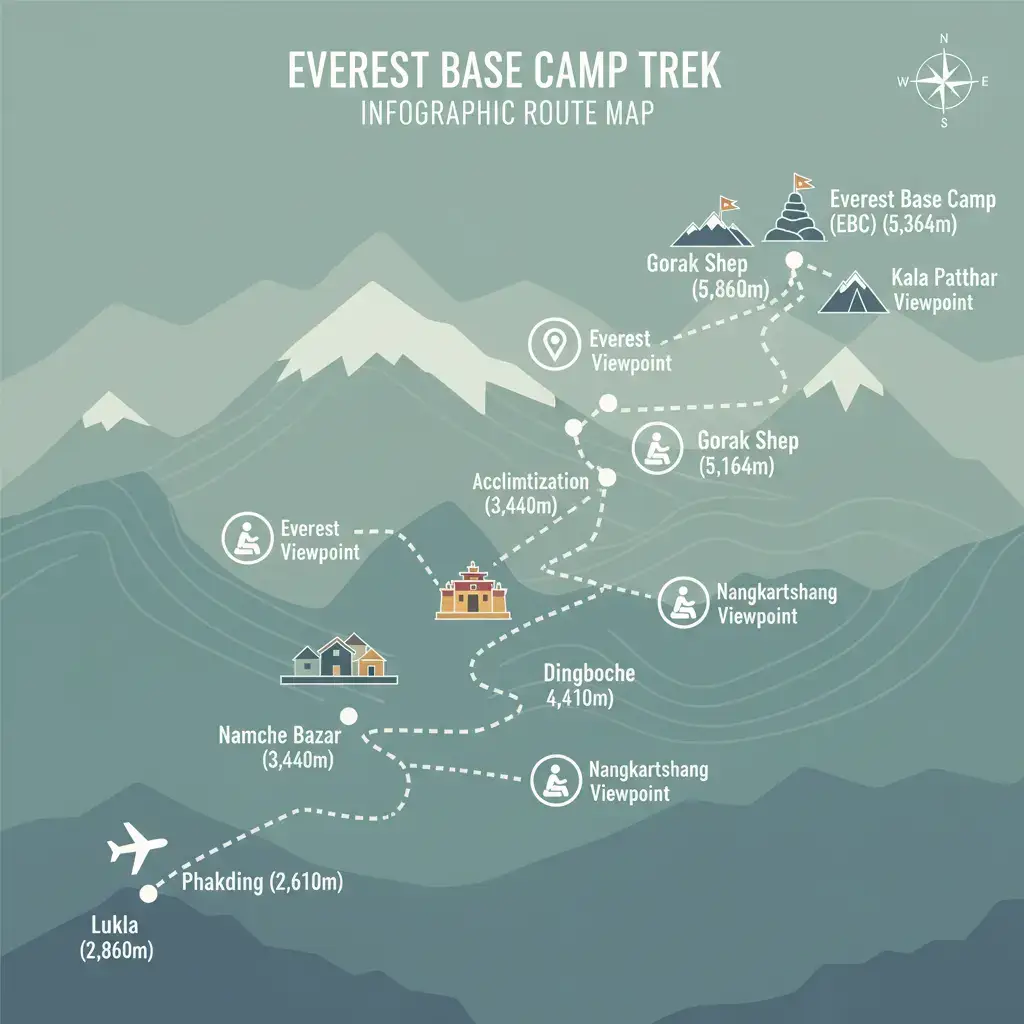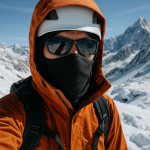Everest Base Camp Trek: Itinerary, Tips & Complete Guide
The Everest Base Camp trek is more than just a walk in the mountains; it’s a pilgrimage to the foot of the world’s highest peak. Considered one of the most iconic treks on the planet, it offers a breathtaking blend of natural grandeur and profound cultural immersion. Trekkers traverse stunning Himalayan landscapes, passing fluttering prayer flags and delving into the heart of the vibrant Sherpa culture.
This journey does not require you to be an elite mountaineer, yet it demands respect for the altitude and a spirit of adventure. This guide provides everything you need to know to plan your trek, from the daily itinerary and costs to packing lists and essential tips for staying healthy and safe.
Itinerary & Duration
The classic trek to Everest Base Camp follows a well-trodden path designed for gradual acclimatization. While variations exist, the standard trip takes about 12 days, starting and ending with a flight to the mountain airstrip at Lukla.
Typical 12-Day Everest Base Camp Trek Itinerary
- Day 1-2: Fly to Lukla (2,860m) and trek to Namche Bazaar (3,440m), the bustling capital of the Sherpa region.
- Day 3: Acclimatization day in Namche to help your body adjust to the altitude.
- Day 4-5: Trek to Tengboche (3,860m), home to a famous monastery, and continue to Dingboche (4,410m).
- Day 6: A second crucial acclimatization day in Dingboche.
- Day 7-8: Ascend to Lobuche (4,940m) and then to Gorak Shep (5,164m), the last settlement before EBC. From here, make the final push to Everest Base Camp (5,364m).
- Day 9: An early morning hike up Kala Patthar (5,545m) for sunrise views of Everest, then begin the descent.
- Day 10-12: Trek back down to Lukla and fly back to Kathmandu.
![]()
Difficulty & Preparation
The EBC trek difficulty is rated as moderate to challenging. There is no technical climbing involved, and the trails are generally well-maintained. The primary challenge lies in the high altitude.
A good level of physical fitness is required, as you will be walking for 5-7 hours each day. The most important preparation is understanding the risks of Everest Base Camp trek altitude sickness. The itinerary is specifically designed with two acclimatization days to minimize this risk. Listen to your body, walk slowly (“bistari, bistari” in Nepali), and stay hydrated.
Best Seasons to Trek
The best time to trek Everest Base Camp is during the two main trekking seasons, which offer stable weather and clear skies.
- Spring (March to May): The weather is warming up, and the rhododendron forests are in full bloom. The climbing season is underway, so Base Camp is a bustling city of tents.
- Autumn (September to November): This season offers the clearest skies and most stable weather post-monsoon. The air is crisp, and the vistas are typically spectacular.
Trekking in winter (Dec-Feb) is possible but extremely cold, while the summer monsoon (Jun-Aug) brings rain and cloudy skies, obscuring the views.
Costs & Permits
The Everest Base Camp trek cost is significantly lower than a full climbing expedition. It is accessible to a wide range of budgets, depending on your preferred level of comfort.
Required Permits
You will need two main permits, which can be easily obtained in Lukla or Monjo:
- Khumbu Pasang Lhamu Rural Municipality Permit: ~$20 USD.
- Sagarmatha National Park Entry Permit: ~$30 USD.
Note: The TIMS (Trekkers’ Information Management Systems) card is no longer required for the Everest region as of 2020.
Total Trip Cost
An independent trekker can complete the trek for as little as $1,000. A typical guided trek with a local company costs around $1,500 – $2,500, while a premium service with a Western operator can be over $4,000. These costs typically include permits, guide/porter, domestic flights, food, and accommodation. Learn how this compares to the cost of a full summit expedition.
Sights & Highlights
The journey is just as important as the destination. The trek is filled with unforgettable cultural and natural wonders.
- Namche Bazaar: The vibrant heart of the Khumbu, a horseshoe-shaped village filled with shops, bakeries, and lodges.
- Tengboche Monastery: The most important spiritual center in the region, offering stunning views of Ama Dablam and Everest. Visiting the monastery is a key part of understanding Sherpa culture.
- Kala Patthar (5,545 m): The “black rock” viewpoint above Gorak Shep. This is where you get the iconic, postcard-perfect view of the Mount Everest summit.
- Everest Base Camp (5,364 m): The ultimate destination. While you can’t see the summit from here, standing amidst the Khumbu Glacier at the launchpad for summit attempts is a powerful experience. It’s the starting point for the famous South Col climbing route.
Logistics: Flights, Lodges & Food
A smooth trek relies on well-planned logistics, from the thrilling flight to Lukla to the cozy teahouses where you’ll rest each night.
- Flights to Lukla: The trek begins with a 30-minute flight from Kathmandu to Tenzing-Hillary Airport in Lukla, often cited as one of the world’s most dramatic airports.
- Accommodation: You’ll stay in “teahouses” or lodges along the trail. These offer basic but comfortable twin-bed rooms and a communal dining hall with a stove for warmth.
- Food & Drink: The staple food is Dal Bhat (lentil soup with rice), which is nutritious and delicious. You’ll also find a variety of other dishes like pasta, momos (dumplings), and pizza.
Packing List Essentials
Packing smart is crucial. You need to be prepared for a wide range of temperatures, from sunny afternoons to freezing nights.

Key items include broken-in hiking boots, a warm down jacket, a layered clothing system, a -15°C to -20°C sleeping bag, and trekking poles. This trekking gear is significantly different from the specialized equipment needed for a summit attempt. For a complete checklist, see our EBC trek packing list.
Key Takeaways
- The Everest Base Camp trek is an achievable goal for fit walkers and one of the world’s most rewarding adventures.
- A typical itinerary takes 12-14 days and is designed for safe acclimatization to the high altitude.
- The trek is a unique blend of spectacular mountain scenery and rich Sherpa culture, with highlights like Namche Bazaar and Tengboche Monastery.
- Proper planning, including choosing the right season and packing the essential gear, is key to a successful and enjoyable journey.
Frequently Asked Questions (FAQ)
How long is the Everest Base Camp trek?
The classic Everest Base Camp trek itinerary is typically 12 to 14 days, starting and ending with the flight to Lukla. This duration includes 8-9 days of trekking to Base Camp and 3-4 days to descend, with crucial acclimatization days built in to help prevent altitude sickness.
How difficult is the EBC trek?
The EBC trek is considered moderate to challenging. It does not require any technical climbing skills, but it involves long days of walking at progressively high altitudes (up to 5,545 meters at Kala Patthar). A good level of cardiovascular fitness is essential, and the main difficulty for most trekkers is the high altitude, not the terrain itself.
What is the cost of the Everest Base Camp trek?
The cost of the Everest Base Camp trek can range from $1,000 to over $4,000 per person, excluding international flights. A budget trek with a local company might be around $1,500, while a more comfortable, all-inclusive trek with a Western operator can be $3,000 or more. Key costs include permits, flights to Lukla, guide/porter fees, food, and accommodation.
What is the altitude of Everest Base Camp?
The altitude of Mount Everest Base Camp on the south side in Nepal is approximately 5,364 meters (17,598 feet) above sea level. Most trekkers also climb to the viewpoint of Kala Patthar, which is even higher at 5,545 meters (18,192 feet), for the best views of the Everest summit.

Daniel Whitaker is a mountain journalist and lifelong climber with over 15 years of experience in the European Alps and the Andes. Although he has not yet attempted Mount Everest, he has summited several 6,000-meter peaks in South America and multiple classic alpine routes in the Mont Blanc massif. Daniel specializes in writing about the culture, history, and psychology of mountaineering. His work combines first-hand mountaineering experience with extensive research on Himalayan expeditions, making him an engaging guide to Everest’s enduring myths, records, and inspirational quotes.
